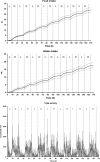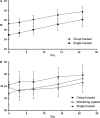The effects of group and single housing and automated animal monitoring on urinary corticosterone levels in male C57BL/6 mice
- PMID: 26869685
- PMCID: PMC4758932
- DOI: 10.14814/phy2.12703
The effects of group and single housing and automated animal monitoring on urinary corticosterone levels in male C57BL/6 mice
Abstract
Mice are used extensively in physiological research. Automated home-cage systems have been developed to study single-housed animals. Increased stress by different housing conditions might affect greatly the results when investigating metabolic responses. Urinary corticosteroid concentration is considered as a stress marker. The aim of the study was to compare the effects of different housing conditions and an automated home-cage system with indirect calorimetry located in an environmental chamber on corticosterone levels in mice. Male mice were housed in different conditions and in automated home-cage system to evaluate the effects of housing and measuring conditions on urine corticosterone levels. Corticosterone levels in single-housed mice in the laboratory animal center were consistently lower compared with the group-housed mice. Single-housed mice in a separate, small animal unit showed a rise in their corticosterone levels a day after they were separated to their individual cages, which decreased during the following 2 days. The corticosterone levels of group-housed mice in the same unit were increased during the first 7 days and then decreased. On day 7, the corticosterone concentrations of group-housed mice were significantly higher compared with that of single-housed mice, including the metabolic measurement protocol. In conclusion, single housing caused less stress when compared with group-housed mice. In addition, the urine corticosterone levels were decreased in single-housed mice before the metabolic measurement started. Thus, stress does not affect the results when utilizing the automated system for measuring metabolic parameters like food and water intake and calorimetry.
Keywords: metabolic measurements; mice; stress; urinary corticosterone.
© 2016 The Authors. Physiological Reports published by Wiley Periodicals, Inc. on behalf of the American Physiological Society and The Physiological Society.
Figures






Similar articles
-
Effect of metabolic cage housing on immunoglobulin A and corticosterone excretion in faeces and urine of young male rats.Exp Physiol. 2004 Jul;89(4):427-33. doi: 10.1113/expphysiol.2004.027656. Epub 2004 May 6. Exp Physiol. 2004. PMID: 15131075
-
Effects of separated pair housing of female C57BL/6JRj mice on well-being.Sci Rep. 2022 May 25;12(1):8819. doi: 10.1038/s41598-022-12846-6. Sci Rep. 2022. PMID: 35614188 Free PMC article.
-
Individual housing of mice--impact on behaviour and stress responses.Physiol Behav. 2009 Jun 22;97(3-4):385-93. doi: 10.1016/j.physbeh.2009.03.008. Epub 2009 Mar 18. Physiol Behav. 2009. PMID: 19303031
-
A systematic review of the development and application of home cage monitoring in laboratory mice and rats.BMC Biol. 2023 Nov 13;21(1):256. doi: 10.1186/s12915-023-01751-7. BMC Biol. 2023. PMID: 37953247 Free PMC article.
-
Measuring Locomotor Activity and Behavioral Aspects of Rodents Living in the Home-Cage.Front Behav Neurosci. 2022 Apr 7;16:877323. doi: 10.3389/fnbeh.2022.877323. eCollection 2022. Front Behav Neurosci. 2022. PMID: 35464142 Free PMC article. Review.
Cited by
-
A Murine Frailty Index Based on Clinical and Laboratory Measurements: Links Between Frailty and Pro-inflammatory Cytokines Differ in a Sex-Specific Manner.J Gerontol A Biol Sci Med Sci. 2019 Feb 15;74(3):275-282. doi: 10.1093/gerona/gly117. J Gerontol A Biol Sci Med Sci. 2019. PMID: 29788087 Free PMC article.
-
Analytic and Interpretational Pitfalls to Measuring Fecal Corticosterone Metabolites in Laboratory Rats and Mice.Comp Med. 2019 Oct 1;69(5):337-349. doi: 10.30802/AALAS-CM-18-000119. Epub 2019 Oct 2. Comp Med. 2019. PMID: 31578162 Free PMC article. Review.
-
Roadbumps at the Crossroads of Integrating Behavioral and In Vitro Approaches for Neurotoxicity Assessment.Front Toxicol. 2022 Feb 25;4:812863. doi: 10.3389/ftox.2022.812863. eCollection 2022. Front Toxicol. 2022. PMID: 35295216 Free PMC article. Review.
-
Individualized Housing Modifies the Immune-Endocrine System in CD1 Adult Male Mice.Animals (Basel). 2023 Mar 10;13(6):1026. doi: 10.3390/ani13061026. Animals (Basel). 2023. PMID: 36978567 Free PMC article.
-
Exposure to chronic variable social stress during adolescence alters affect-related behaviors and adrenocortical activity in adult male and female inbred mice.Dev Psychobiol. 2017 Sep;59(6):679-687. doi: 10.1002/dev.21541. Epub 2017 Jul 5. Dev Psychobiol. 2017. PMID: 28678409 Free PMC article.
References
-
- Arndt, S. S. , Laarakker M. C., van Lith H. A., van der Staay F. J., Gieling E., Salomons A. R., et al. 2009. Individual housing of mice–impact on behaviour and stress responses. Physiol. Behav. 97:385–393. - PubMed
-
- Bamberg, E. , Palme R., and Meingassner J. G.. 2001. Excretion of corticosteroid metabolites in urine and faeces of rats. Lab. Anim. 35:307–314. - PubMed
-
- Bartolomucci, A. , Palanza P., Sacerdote P., Ceresini G., Chirieleison A., Panerai A. E., et al. 2003. Individual housing induces altered immuno‐endocrine responses to psychological stress in male mice. Psychoneuroendocrinology 28:540–558. - PubMed
-
- Bartolomucci, A. , Cabassi A., Govoni P., Ceresini G., Cero C., Berra D., et al. 2009. Metabolic consequences and vulnerability to diet‐induced obesity in male mice under chronic social stress. PLoS ONE 4:e4331. doi: 10.1371/journal.pone.0004331. - DOI - PMC - PubMed
-
- Brown, K. J. , and Grunberg N. E.. 1995. Effects of housing on male and female rats: crowding stresses male but calm females. Physiol. Behav. 58:1085–1089. - PubMed
Publication types
MeSH terms
Substances
LinkOut - more resources
Full Text Sources
Other Literature Sources
Medical

